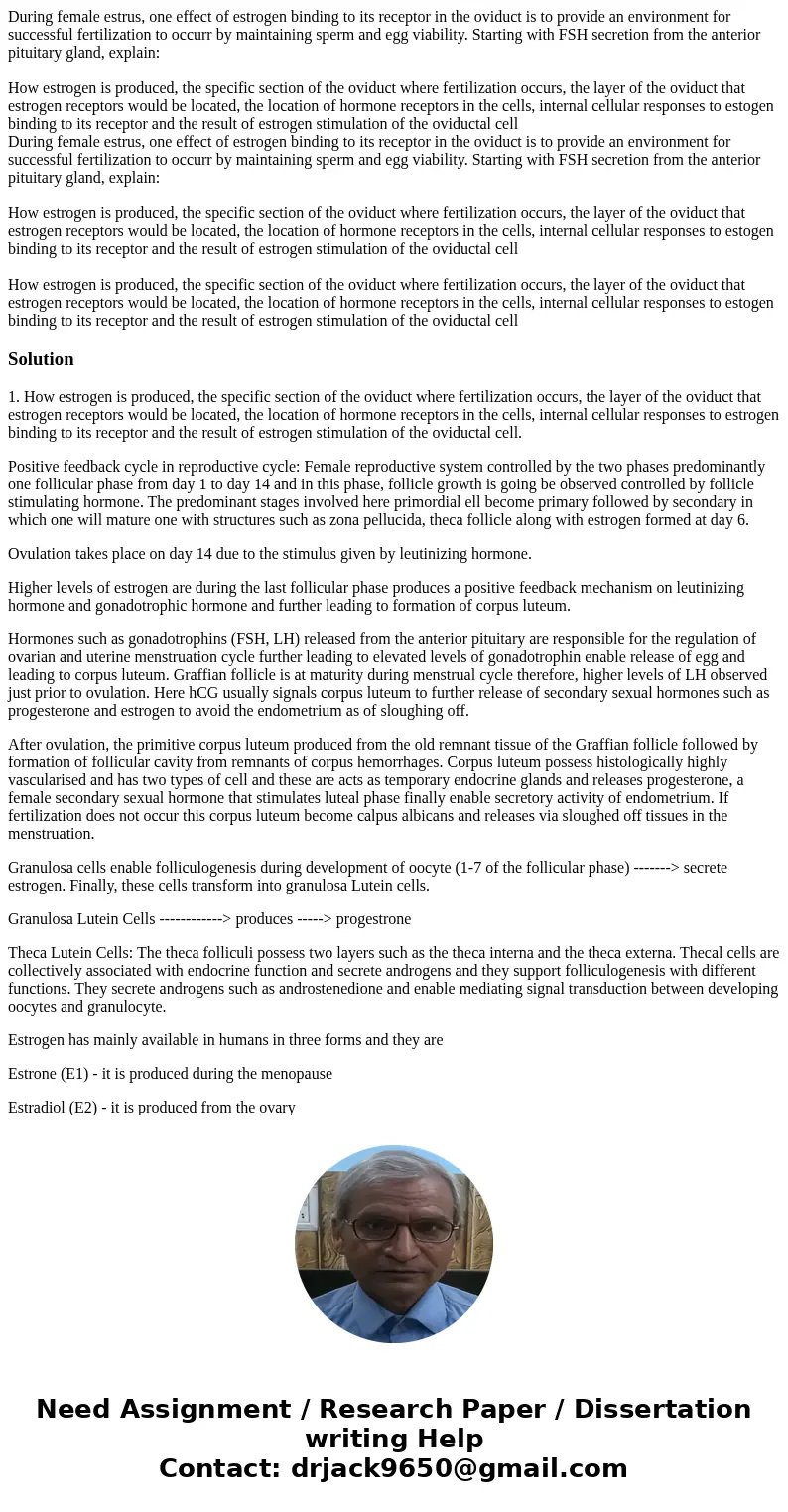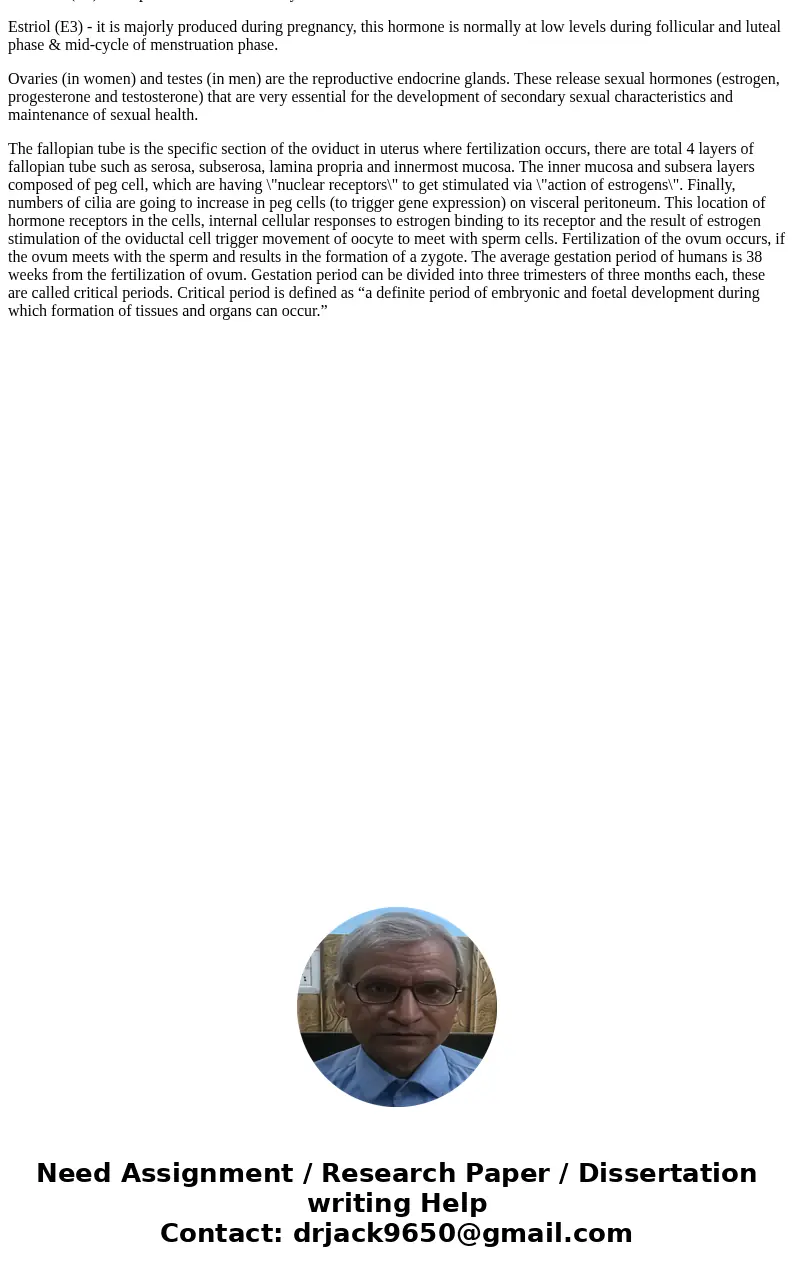During female estrus one effect of estrogen binding to its r
Solution
1. How estrogen is produced, the specific section of the oviduct where fertilization occurs, the layer of the oviduct that estrogen receptors would be located, the location of hormone receptors in the cells, internal cellular responses to estrogen binding to its receptor and the result of estrogen stimulation of the oviductal cell.
Positive feedback cycle in reproductive cycle: Female reproductive system controlled by the two phases predominantly one follicular phase from day 1 to day 14 and in this phase, follicle growth is going be observed controlled by follicle stimulating hormone. The predominant stages involved here primordial ell become primary followed by secondary in which one will mature one with structures such as zona pellucida, theca follicle along with estrogen formed at day 6.
Ovulation takes place on day 14 due to the stimulus given by leutinizing hormone.
Higher levels of estrogen are during the last follicular phase produces a positive feedback mechanism on leutinizing hormone and gonadotrophic hormone and further leading to formation of corpus luteum.
Hormones such as gonadotrophins (FSH, LH) released from the anterior pituitary are responsible for the regulation of ovarian and uterine menstruation cycle further leading to elevated levels of gonadotrophin enable release of egg and leading to corpus luteum. Graffian follicle is at maturity during menstrual cycle therefore, higher levels of LH observed just prior to ovulation. Here hCG usually signals corpus luteum to further release of secondary sexual hormones such as progesterone and estrogen to avoid the endometrium as of sloughing off.
After ovulation, the primitive corpus luteum produced from the old remnant tissue of the Graffian follicle followed by formation of follicular cavity from remnants of corpus hemorrhages. Corpus luteum possess histologically highly vascularised and has two types of cell and these are acts as temporary endocrine glands and releases progesterone, a female secondary sexual hormone that stimulates luteal phase finally enable secretory activity of endometrium. If fertilization does not occur this corpus luteum become calpus albicans and releases via sloughed off tissues in the menstruation.
Granulosa cells enable folliculogenesis during development of oocyte (1-7 of the follicular phase) -------> secrete estrogen. Finally, these cells transform into granulosa Lutein cells.
Granulosa Lutein Cells ------------> produces -----> progestrone
Theca Lutein Cells: The theca folliculi possess two layers such as the theca interna and the theca externa. Thecal cells are collectively associated with endocrine function and secrete androgens and they support folliculogenesis with different functions. They secrete androgens such as androstenedione and enable mediating signal transduction between developing oocytes and granulocyte.
Estrogen has mainly available in humans in three forms and they are
Estrone (E1) - it is produced during the menopause
Estradiol (E2) - it is produced from the ovary
Estriol (E3) - it is majorly produced during pregnancy, this hormone is normally at low levels during follicular and luteal phase & mid-cycle of menstruation phase.
Ovaries (in women) and testes (in men) are the reproductive endocrine glands. These release sexual hormones (estrogen, progesterone and testosterone) that are very essential for the development of secondary sexual characteristics and maintenance of sexual health.
The fallopian tube is the specific section of the oviduct in uterus where fertilization occurs, there are total 4 layers of fallopian tube such as serosa, subserosa, lamina propria and innermost mucosa. The inner mucosa and subsera layers composed of peg cell, which are having \"nuclear receptors\" to get stimulated via \"action of estrogens\". Finally, numbers of cilia are going to increase in peg cells (to trigger gene expression) on visceral peritoneum. This location of hormone receptors in the cells, internal cellular responses to estrogen binding to its receptor and the result of estrogen stimulation of the oviductal cell trigger movement of oocyte to meet with sperm cells. Fertilization of the ovum occurs, if the ovum meets with the sperm and results in the formation of a zygote. The average gestation period of humans is 38 weeks from the fertilization of ovum. Gestation period can be divided into three trimesters of three months each, these are called critical periods. Critical period is defined as “a definite period of embryonic and foetal development during which formation of tissues and organs can occur.”


 Homework Sourse
Homework Sourse